Analysis of Nestle's HR Practices to Meet International Standards
VerifiedAdded on 2021/02/20
|25
|5428
|31
Project
AI Summary
This project delves into the strategies multinational companies, specifically Nestle, employ to enhance their recruitment, selection, and training processes to align with international requirements. The project begins with an introduction outlining the aims and objectives, focusing on people development as a key driver of globalization and the importance of ethical HR practices. It then presents a project management plan with components such as cost, time, scope, risk, and communication, tailored for Nestle's HR improvements. The project incorporates Gantt charts and WBS structures for effective task management. The research methodology includes both qualitative and quantitative methods, with data collected from primary and secondary sources, including questionnaires. The findings analyze the processes for reviewing people development, identifying the need for changes in HR practices, and highlighting the advantages of such improvements. The project also addresses challenges and strategies for successful implementation, offering recommendations for Nestle to meet its global objectives. Finally, the project concludes with a reflection on the findings and the overall impact of the analysis.
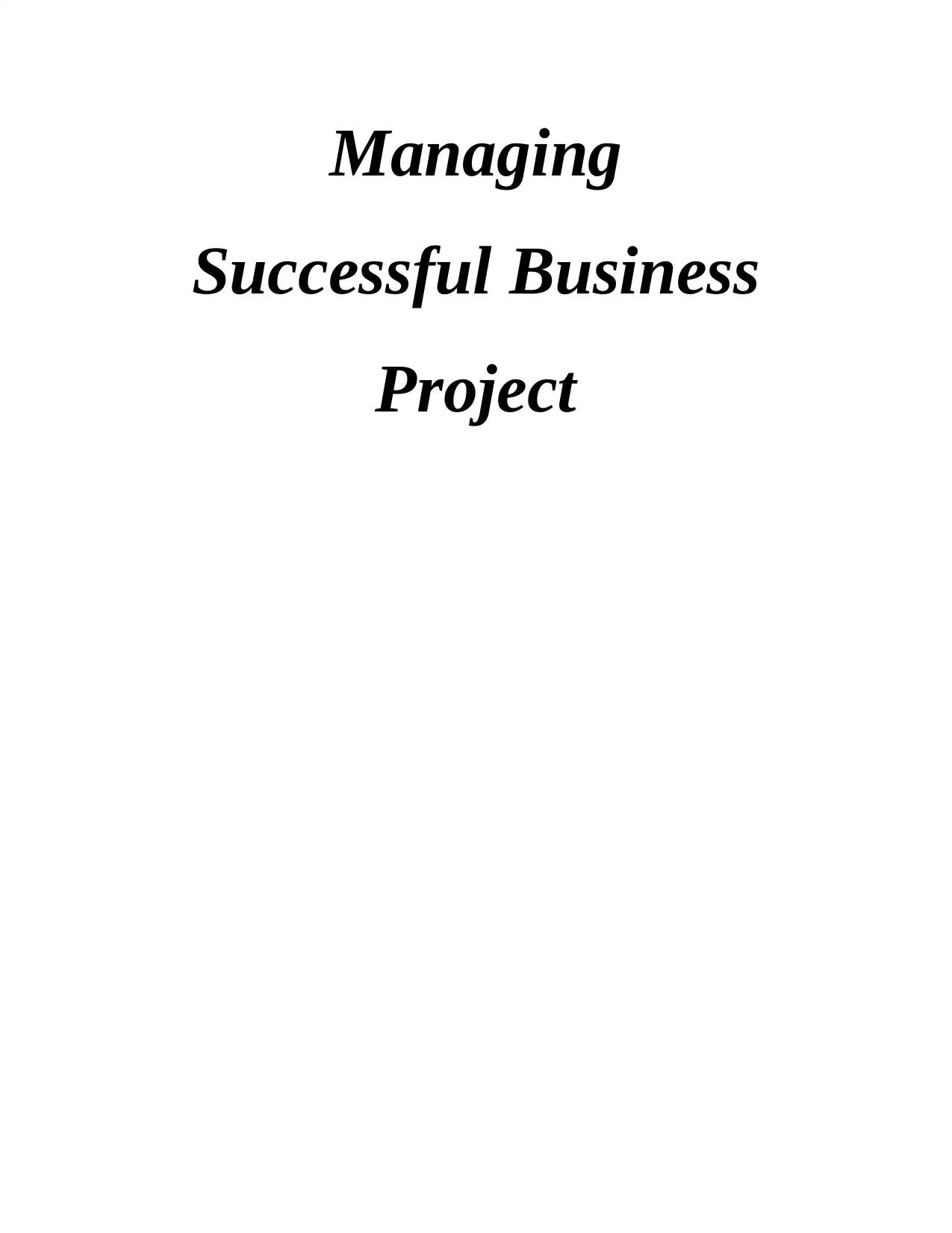
Managing
Successful Business
Project
Successful Business
Project
Paraphrase This Document
Need a fresh take? Get an instant paraphrase of this document with our AI Paraphraser
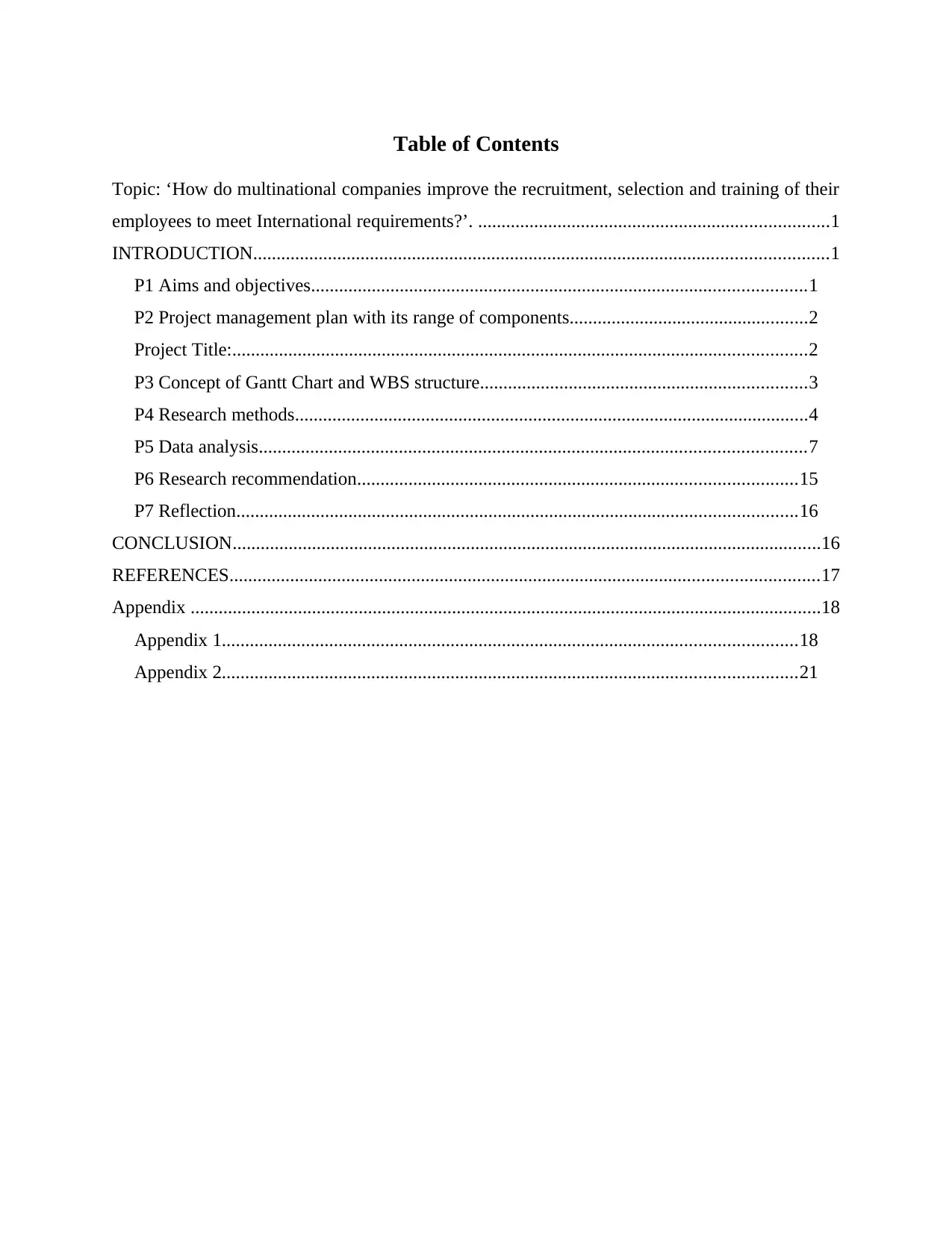
Table of Contents
Topic: ‘How do multinational companies improve the recruitment, selection and training of their
employees to meet International requirements?’. ...........................................................................1
INTRODUCTION...........................................................................................................................1
P1 Aims and objectives..........................................................................................................1
P2 Project management plan with its range of components...................................................2
Project Title:...........................................................................................................................2
P3 Concept of Gantt Chart and WBS structure......................................................................3
P4 Research methods..............................................................................................................4
P5 Data analysis.....................................................................................................................7
P6 Research recommendation..............................................................................................15
P7 Reflection........................................................................................................................16
CONCLUSION..............................................................................................................................16
REFERENCES..............................................................................................................................17
Appendix .......................................................................................................................................18
Appendix 1...........................................................................................................................18
Appendix 2...........................................................................................................................21
Topic: ‘How do multinational companies improve the recruitment, selection and training of their
employees to meet International requirements?’. ...........................................................................1
INTRODUCTION...........................................................................................................................1
P1 Aims and objectives..........................................................................................................1
P2 Project management plan with its range of components...................................................2
Project Title:...........................................................................................................................2
P3 Concept of Gantt Chart and WBS structure......................................................................3
P4 Research methods..............................................................................................................4
P5 Data analysis.....................................................................................................................7
P6 Research recommendation..............................................................................................15
P7 Reflection........................................................................................................................16
CONCLUSION..............................................................................................................................16
REFERENCES..............................................................................................................................17
Appendix .......................................................................................................................................18
Appendix 1...........................................................................................................................18
Appendix 2...........................................................................................................................21

⊘ This is a preview!⊘
Do you want full access?
Subscribe today to unlock all pages.

Trusted by 1+ million students worldwide
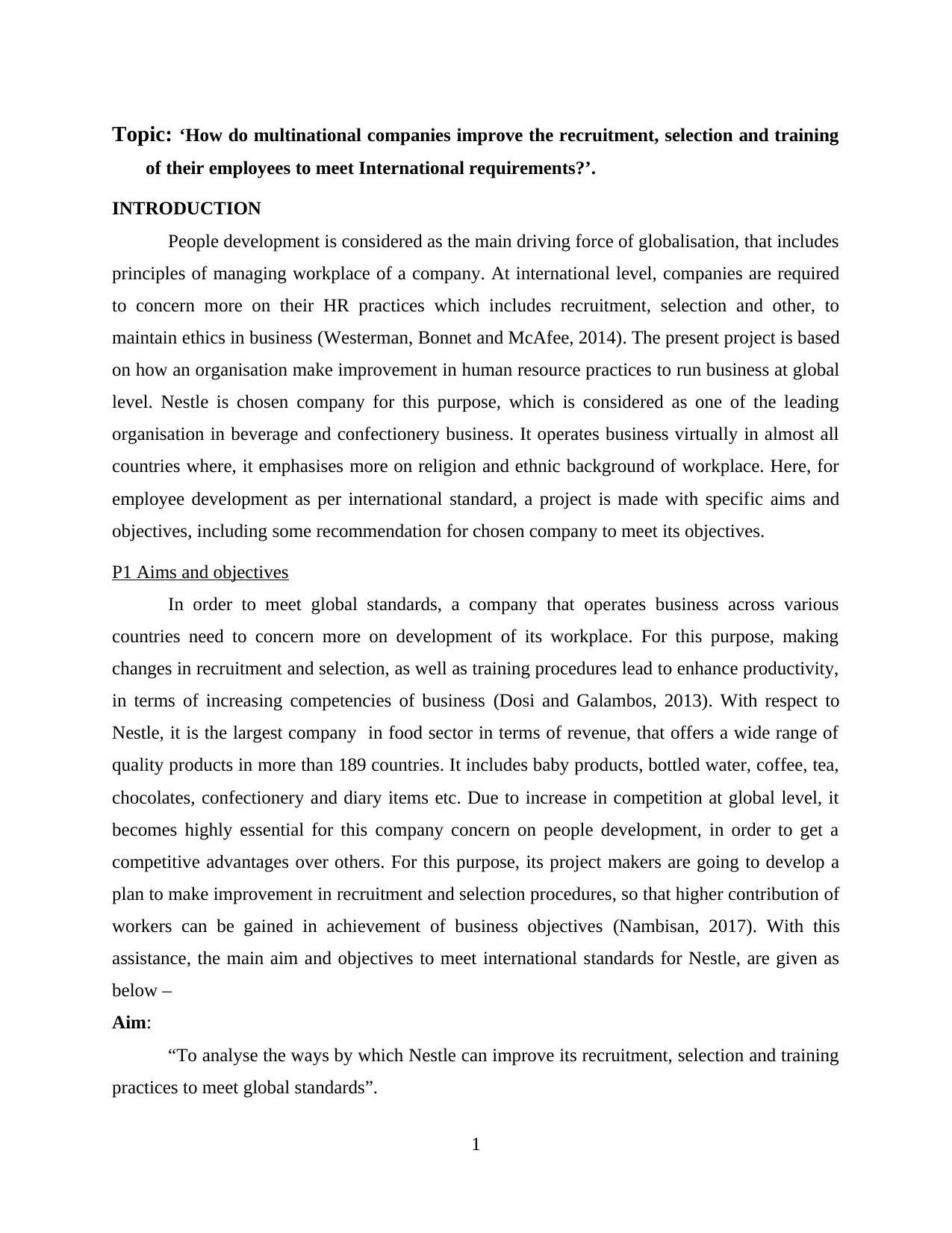
Topic: ‘How do multinational companies improve the recruitment, selection and training
of their employees to meet International requirements?’.
INTRODUCTION
People development is considered as the main driving force of globalisation, that includes
principles of managing workplace of a company. At international level, companies are required
to concern more on their HR practices which includes recruitment, selection and other, to
maintain ethics in business (Westerman, Bonnet and McAfee, 2014). The present project is based
on how an organisation make improvement in human resource practices to run business at global
level. Nestle is chosen company for this purpose, which is considered as one of the leading
organisation in beverage and confectionery business. It operates business virtually in almost all
countries where, it emphasises more on religion and ethnic background of workplace. Here, for
employee development as per international standard, a project is made with specific aims and
objectives, including some recommendation for chosen company to meet its objectives.
P1 Aims and objectives
In order to meet global standards, a company that operates business across various
countries need to concern more on development of its workplace. For this purpose, making
changes in recruitment and selection, as well as training procedures lead to enhance productivity,
in terms of increasing competencies of business (Dosi and Galambos, 2013). With respect to
Nestle, it is the largest company in food sector in terms of revenue, that offers a wide range of
quality products in more than 189 countries. It includes baby products, bottled water, coffee, tea,
chocolates, confectionery and diary items etc. Due to increase in competition at global level, it
becomes highly essential for this company concern on people development, in order to get a
competitive advantages over others. For this purpose, its project makers are going to develop a
plan to make improvement in recruitment and selection procedures, so that higher contribution of
workers can be gained in achievement of business objectives (Nambisan, 2017). With this
assistance, the main aim and objectives to meet international standards for Nestle, are given as
below –
Aim:
“To analyse the ways by which Nestle can improve its recruitment, selection and training
practices to meet global standards”.
1
of their employees to meet International requirements?’.
INTRODUCTION
People development is considered as the main driving force of globalisation, that includes
principles of managing workplace of a company. At international level, companies are required
to concern more on their HR practices which includes recruitment, selection and other, to
maintain ethics in business (Westerman, Bonnet and McAfee, 2014). The present project is based
on how an organisation make improvement in human resource practices to run business at global
level. Nestle is chosen company for this purpose, which is considered as one of the leading
organisation in beverage and confectionery business. It operates business virtually in almost all
countries where, it emphasises more on religion and ethnic background of workplace. Here, for
employee development as per international standard, a project is made with specific aims and
objectives, including some recommendation for chosen company to meet its objectives.
P1 Aims and objectives
In order to meet global standards, a company that operates business across various
countries need to concern more on development of its workplace. For this purpose, making
changes in recruitment and selection, as well as training procedures lead to enhance productivity,
in terms of increasing competencies of business (Dosi and Galambos, 2013). With respect to
Nestle, it is the largest company in food sector in terms of revenue, that offers a wide range of
quality products in more than 189 countries. It includes baby products, bottled water, coffee, tea,
chocolates, confectionery and diary items etc. Due to increase in competition at global level, it
becomes highly essential for this company concern on people development, in order to get a
competitive advantages over others. For this purpose, its project makers are going to develop a
plan to make improvement in recruitment and selection procedures, so that higher contribution of
workers can be gained in achievement of business objectives (Nambisan, 2017). With this
assistance, the main aim and objectives to meet international standards for Nestle, are given as
below –
Aim:
“To analyse the ways by which Nestle can improve its recruitment, selection and training
practices to meet global standards”.
1
Paraphrase This Document
Need a fresh take? Get an instant paraphrase of this document with our AI Paraphraser
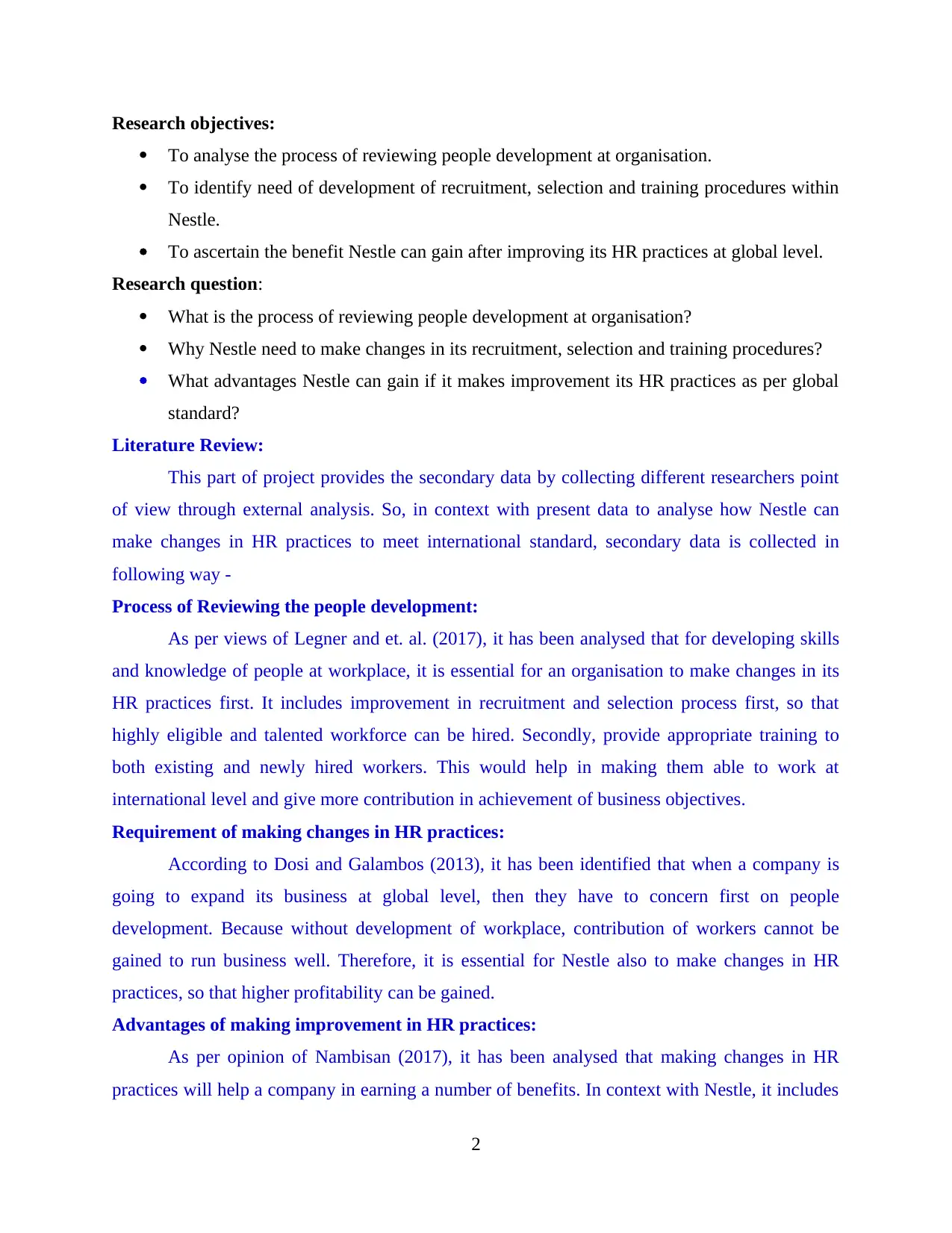
Research objectives:
To analyse the process of reviewing people development at organisation.
To identify need of development of recruitment, selection and training procedures within
Nestle.
To ascertain the benefit Nestle can gain after improving its HR practices at global level.
Research question:
What is the process of reviewing people development at organisation?
Why Nestle need to make changes in its recruitment, selection and training procedures?
What advantages Nestle can gain if it makes improvement its HR practices as per global
standard?
Literature Review:
This part of project provides the secondary data by collecting different researchers point
of view through external analysis. So, in context with present data to analyse how Nestle can
make changes in HR practices to meet international standard, secondary data is collected in
following way -
Process of Reviewing the people development:
As per views of Legner and et. al. (2017), it has been analysed that for developing skills
and knowledge of people at workplace, it is essential for an organisation to make changes in its
HR practices first. It includes improvement in recruitment and selection process first, so that
highly eligible and talented workforce can be hired. Secondly, provide appropriate training to
both existing and newly hired workers. This would help in making them able to work at
international level and give more contribution in achievement of business objectives.
Requirement of making changes in HR practices:
According to Dosi and Galambos (2013), it has been identified that when a company is
going to expand its business at global level, then they have to concern first on people
development. Because without development of workplace, contribution of workers cannot be
gained to run business well. Therefore, it is essential for Nestle also to make changes in HR
practices, so that higher profitability can be gained.
Advantages of making improvement in HR practices:
As per opinion of Nambisan (2017), it has been analysed that making changes in HR
practices will help a company in earning a number of benefits. In context with Nestle, it includes
2
To analyse the process of reviewing people development at organisation.
To identify need of development of recruitment, selection and training procedures within
Nestle.
To ascertain the benefit Nestle can gain after improving its HR practices at global level.
Research question:
What is the process of reviewing people development at organisation?
Why Nestle need to make changes in its recruitment, selection and training procedures?
What advantages Nestle can gain if it makes improvement its HR practices as per global
standard?
Literature Review:
This part of project provides the secondary data by collecting different researchers point
of view through external analysis. So, in context with present data to analyse how Nestle can
make changes in HR practices to meet international standard, secondary data is collected in
following way -
Process of Reviewing the people development:
As per views of Legner and et. al. (2017), it has been analysed that for developing skills
and knowledge of people at workplace, it is essential for an organisation to make changes in its
HR practices first. It includes improvement in recruitment and selection process first, so that
highly eligible and talented workforce can be hired. Secondly, provide appropriate training to
both existing and newly hired workers. This would help in making them able to work at
international level and give more contribution in achievement of business objectives.
Requirement of making changes in HR practices:
According to Dosi and Galambos (2013), it has been identified that when a company is
going to expand its business at global level, then they have to concern first on people
development. Because without development of workplace, contribution of workers cannot be
gained to run business well. Therefore, it is essential for Nestle also to make changes in HR
practices, so that higher profitability can be gained.
Advantages of making improvement in HR practices:
As per opinion of Nambisan (2017), it has been analysed that making changes in HR
practices will help a company in earning a number of benefits. In context with Nestle, it includes
2
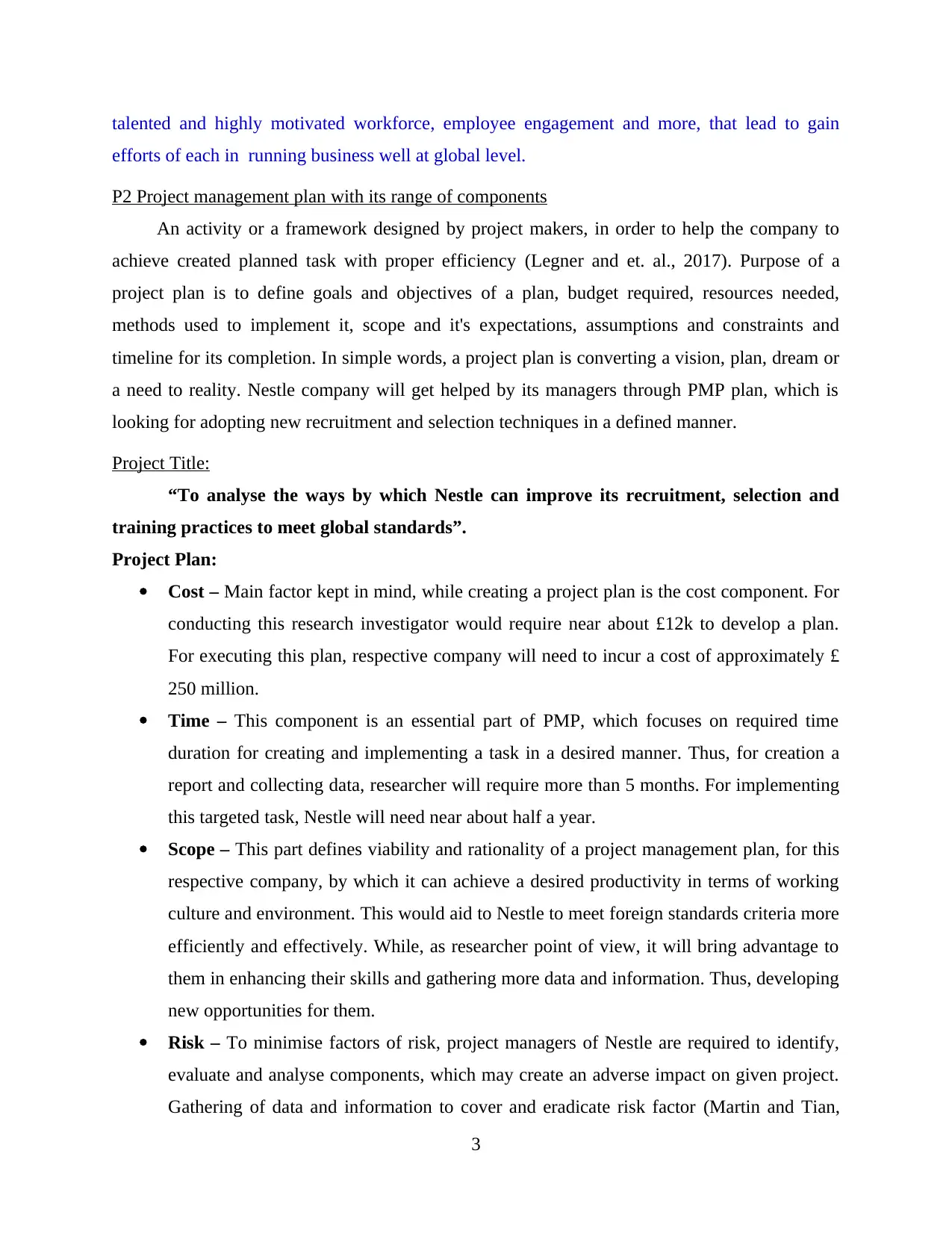
talented and highly motivated workforce, employee engagement and more, that lead to gain
efforts of each in running business well at global level.
P2 Project management plan with its range of components
An activity or a framework designed by project makers, in order to help the company to
achieve created planned task with proper efficiency (Legner and et. al., 2017). Purpose of a
project plan is to define goals and objectives of a plan, budget required, resources needed,
methods used to implement it, scope and it's expectations, assumptions and constraints and
timeline for its completion. In simple words, a project plan is converting a vision, plan, dream or
a need to reality. Nestle company will get helped by its managers through PMP plan, which is
looking for adopting new recruitment and selection techniques in a defined manner.
Project Title:
“To analyse the ways by which Nestle can improve its recruitment, selection and
training practices to meet global standards”.
Project Plan:
Cost – Main factor kept in mind, while creating a project plan is the cost component. For
conducting this research investigator would require near about £12k to develop a plan.
For executing this plan, respective company will need to incur a cost of approximately £
250 million.
Time – This component is an essential part of PMP, which focuses on required time
duration for creating and implementing a task in a desired manner. Thus, for creation a
report and collecting data, researcher will require more than 5 months. For implementing
this targeted task, Nestle will need near about half a year.
Scope – This part defines viability and rationality of a project management plan, for this
respective company, by which it can achieve a desired productivity in terms of working
culture and environment. This would aid to Nestle to meet foreign standards criteria more
efficiently and effectively. While, as researcher point of view, it will bring advantage to
them in enhancing their skills and gathering more data and information. Thus, developing
new opportunities for them.
Risk – To minimise factors of risk, project managers of Nestle are required to identify,
evaluate and analyse components, which may create an adverse impact on given project.
Gathering of data and information to cover and eradicate risk factor (Martin and Tian,
3
efforts of each in running business well at global level.
P2 Project management plan with its range of components
An activity or a framework designed by project makers, in order to help the company to
achieve created planned task with proper efficiency (Legner and et. al., 2017). Purpose of a
project plan is to define goals and objectives of a plan, budget required, resources needed,
methods used to implement it, scope and it's expectations, assumptions and constraints and
timeline for its completion. In simple words, a project plan is converting a vision, plan, dream or
a need to reality. Nestle company will get helped by its managers through PMP plan, which is
looking for adopting new recruitment and selection techniques in a defined manner.
Project Title:
“To analyse the ways by which Nestle can improve its recruitment, selection and
training practices to meet global standards”.
Project Plan:
Cost – Main factor kept in mind, while creating a project plan is the cost component. For
conducting this research investigator would require near about £12k to develop a plan.
For executing this plan, respective company will need to incur a cost of approximately £
250 million.
Time – This component is an essential part of PMP, which focuses on required time
duration for creating and implementing a task in a desired manner. Thus, for creation a
report and collecting data, researcher will require more than 5 months. For implementing
this targeted task, Nestle will need near about half a year.
Scope – This part defines viability and rationality of a project management plan, for this
respective company, by which it can achieve a desired productivity in terms of working
culture and environment. This would aid to Nestle to meet foreign standards criteria more
efficiently and effectively. While, as researcher point of view, it will bring advantage to
them in enhancing their skills and gathering more data and information. Thus, developing
new opportunities for them.
Risk – To minimise factors of risk, project managers of Nestle are required to identify,
evaluate and analyse components, which may create an adverse impact on given project.
Gathering of data and information to cover and eradicate risk factor (Martin and Tian,
3
⊘ This is a preview!⊘
Do you want full access?
Subscribe today to unlock all pages.

Trusted by 1+ million students worldwide
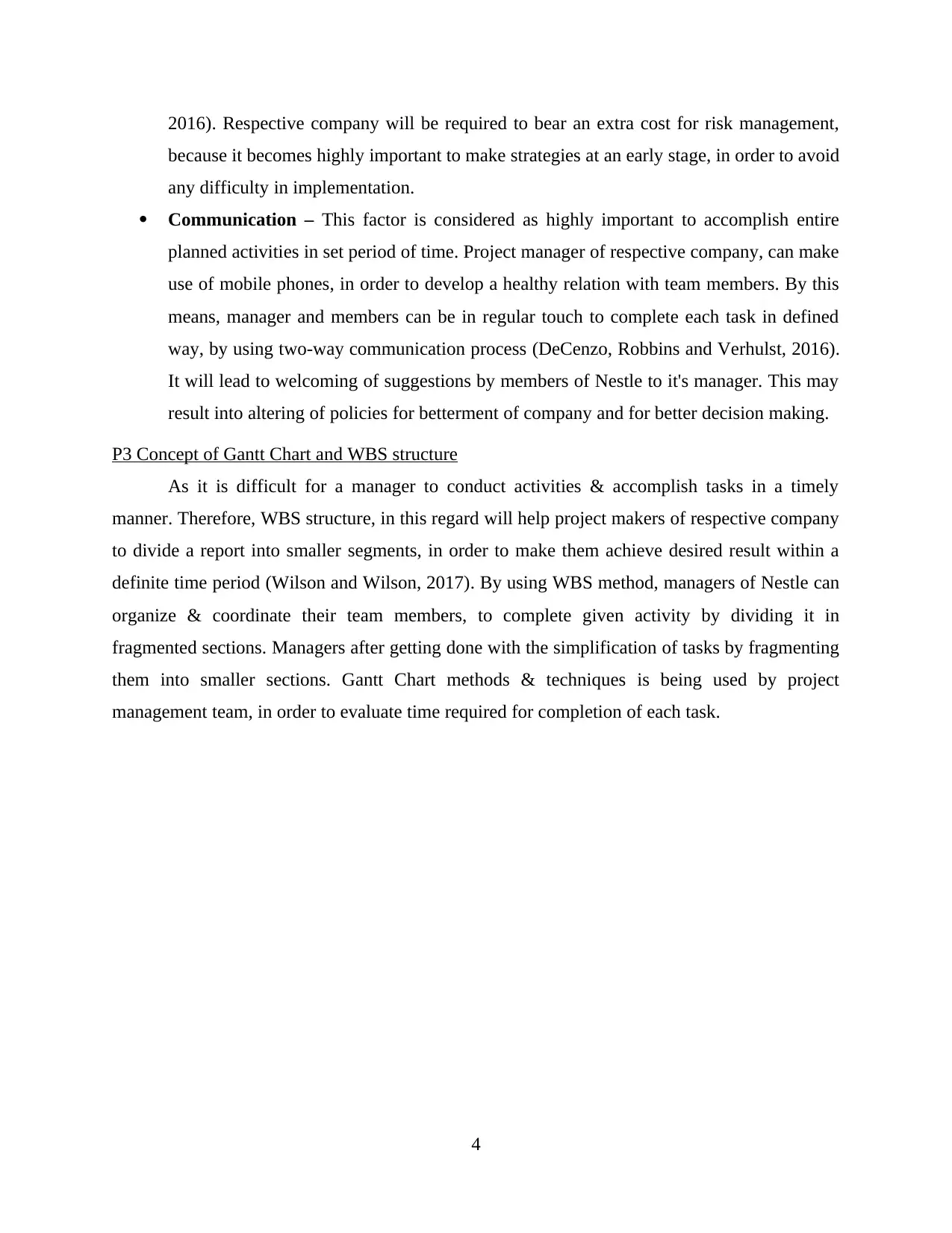
2016). Respective company will be required to bear an extra cost for risk management,
because it becomes highly important to make strategies at an early stage, in order to avoid
any difficulty in implementation.
Communication – This factor is considered as highly important to accomplish entire
planned activities in set period of time. Project manager of respective company, can make
use of mobile phones, in order to develop a healthy relation with team members. By this
means, manager and members can be in regular touch to complete each task in defined
way, by using two-way communication process (DeCenzo, Robbins and Verhulst, 2016).
It will lead to welcoming of suggestions by members of Nestle to it's manager. This may
result into altering of policies for betterment of company and for better decision making.
P3 Concept of Gantt Chart and WBS structure
As it is difficult for a manager to conduct activities & accomplish tasks in a timely
manner. Therefore, WBS structure, in this regard will help project makers of respective company
to divide a report into smaller segments, in order to make them achieve desired result within a
definite time period (Wilson and Wilson, 2017). By using WBS method, managers of Nestle can
organize & coordinate their team members, to complete given activity by dividing it in
fragmented sections. Managers after getting done with the simplification of tasks by fragmenting
them into smaller sections. Gantt Chart methods & techniques is being used by project
management team, in order to evaluate time required for completion of each task.
4
because it becomes highly important to make strategies at an early stage, in order to avoid
any difficulty in implementation.
Communication – This factor is considered as highly important to accomplish entire
planned activities in set period of time. Project manager of respective company, can make
use of mobile phones, in order to develop a healthy relation with team members. By this
means, manager and members can be in regular touch to complete each task in defined
way, by using two-way communication process (DeCenzo, Robbins and Verhulst, 2016).
It will lead to welcoming of suggestions by members of Nestle to it's manager. This may
result into altering of policies for betterment of company and for better decision making.
P3 Concept of Gantt Chart and WBS structure
As it is difficult for a manager to conduct activities & accomplish tasks in a timely
manner. Therefore, WBS structure, in this regard will help project makers of respective company
to divide a report into smaller segments, in order to make them achieve desired result within a
definite time period (Wilson and Wilson, 2017). By using WBS method, managers of Nestle can
organize & coordinate their team members, to complete given activity by dividing it in
fragmented sections. Managers after getting done with the simplification of tasks by fragmenting
them into smaller sections. Gantt Chart methods & techniques is being used by project
management team, in order to evaluate time required for completion of each task.
4
Paraphrase This Document
Need a fresh take? Get an instant paraphrase of this document with our AI Paraphraser
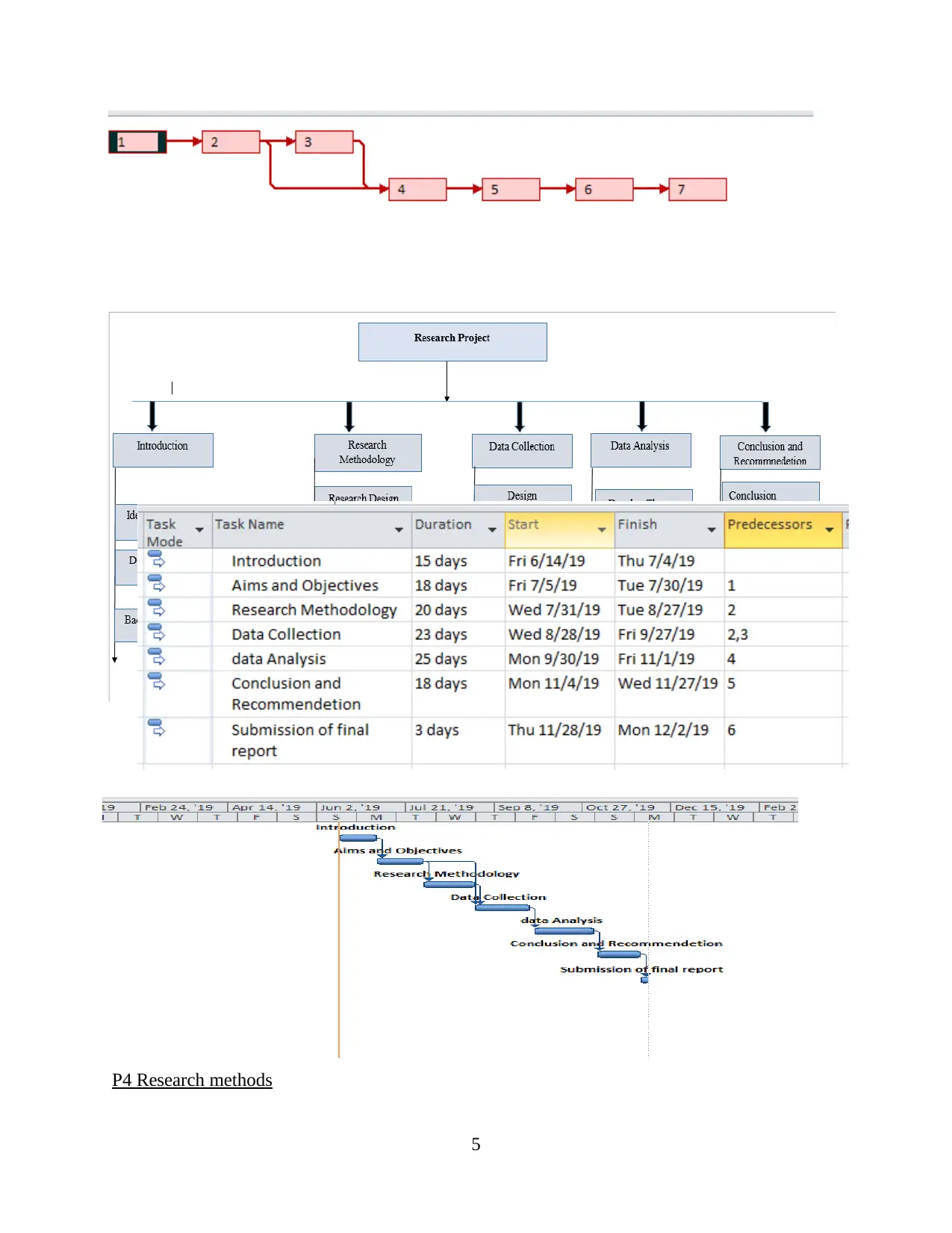
P4 Research methods
5
5
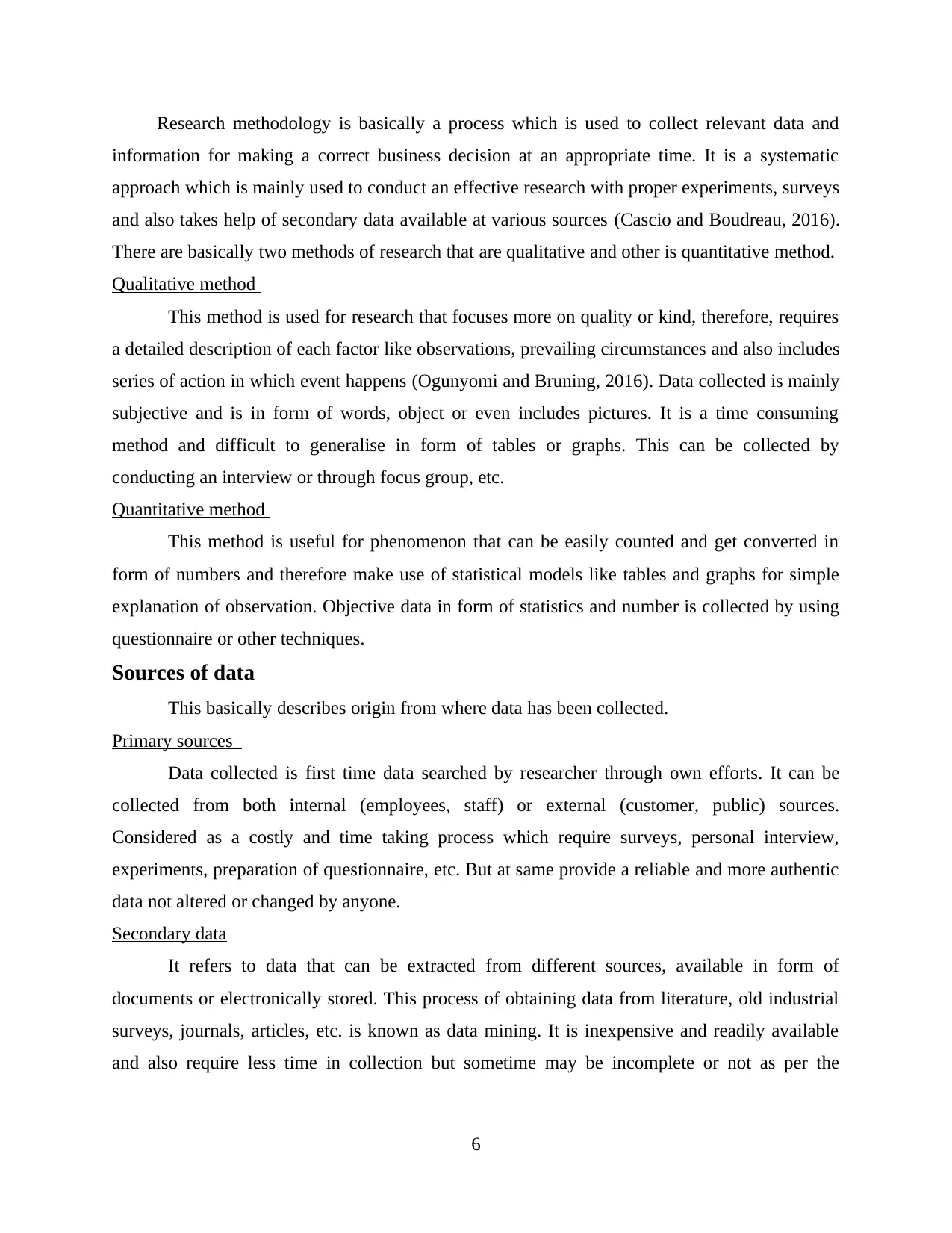
Research methodology is basically a process which is used to collect relevant data and
information for making a correct business decision at an appropriate time. It is a systematic
approach which is mainly used to conduct an effective research with proper experiments, surveys
and also takes help of secondary data available at various sources (Cascio and Boudreau, 2016).
There are basically two methods of research that are qualitative and other is quantitative method.
Qualitative method
This method is used for research that focuses more on quality or kind, therefore, requires
a detailed description of each factor like observations, prevailing circumstances and also includes
series of action in which event happens (Ogunyomi and Bruning, 2016). Data collected is mainly
subjective and is in form of words, object or even includes pictures. It is a time consuming
method and difficult to generalise in form of tables or graphs. This can be collected by
conducting an interview or through focus group, etc.
Quantitative method
This method is useful for phenomenon that can be easily counted and get converted in
form of numbers and therefore make use of statistical models like tables and graphs for simple
explanation of observation. Objective data in form of statistics and number is collected by using
questionnaire or other techniques.
Sources of data
This basically describes origin from where data has been collected.
Primary sources
Data collected is first time data searched by researcher through own efforts. It can be
collected from both internal (employees, staff) or external (customer, public) sources.
Considered as a costly and time taking process which require surveys, personal interview,
experiments, preparation of questionnaire, etc. But at same provide a reliable and more authentic
data not altered or changed by anyone.
Secondary data
It refers to data that can be extracted from different sources, available in form of
documents or electronically stored. This process of obtaining data from literature, old industrial
surveys, journals, articles, etc. is known as data mining. It is inexpensive and readily available
and also require less time in collection but sometime may be incomplete or not as per the
6
information for making a correct business decision at an appropriate time. It is a systematic
approach which is mainly used to conduct an effective research with proper experiments, surveys
and also takes help of secondary data available at various sources (Cascio and Boudreau, 2016).
There are basically two methods of research that are qualitative and other is quantitative method.
Qualitative method
This method is used for research that focuses more on quality or kind, therefore, requires
a detailed description of each factor like observations, prevailing circumstances and also includes
series of action in which event happens (Ogunyomi and Bruning, 2016). Data collected is mainly
subjective and is in form of words, object or even includes pictures. It is a time consuming
method and difficult to generalise in form of tables or graphs. This can be collected by
conducting an interview or through focus group, etc.
Quantitative method
This method is useful for phenomenon that can be easily counted and get converted in
form of numbers and therefore make use of statistical models like tables and graphs for simple
explanation of observation. Objective data in form of statistics and number is collected by using
questionnaire or other techniques.
Sources of data
This basically describes origin from where data has been collected.
Primary sources
Data collected is first time data searched by researcher through own efforts. It can be
collected from both internal (employees, staff) or external (customer, public) sources.
Considered as a costly and time taking process which require surveys, personal interview,
experiments, preparation of questionnaire, etc. But at same provide a reliable and more authentic
data not altered or changed by anyone.
Secondary data
It refers to data that can be extracted from different sources, available in form of
documents or electronically stored. This process of obtaining data from literature, old industrial
surveys, journals, articles, etc. is known as data mining. It is inexpensive and readily available
and also require less time in collection but sometime may be incomplete or not as per the
6
⊘ This is a preview!⊘
Do you want full access?
Subscribe today to unlock all pages.

Trusted by 1+ million students worldwide
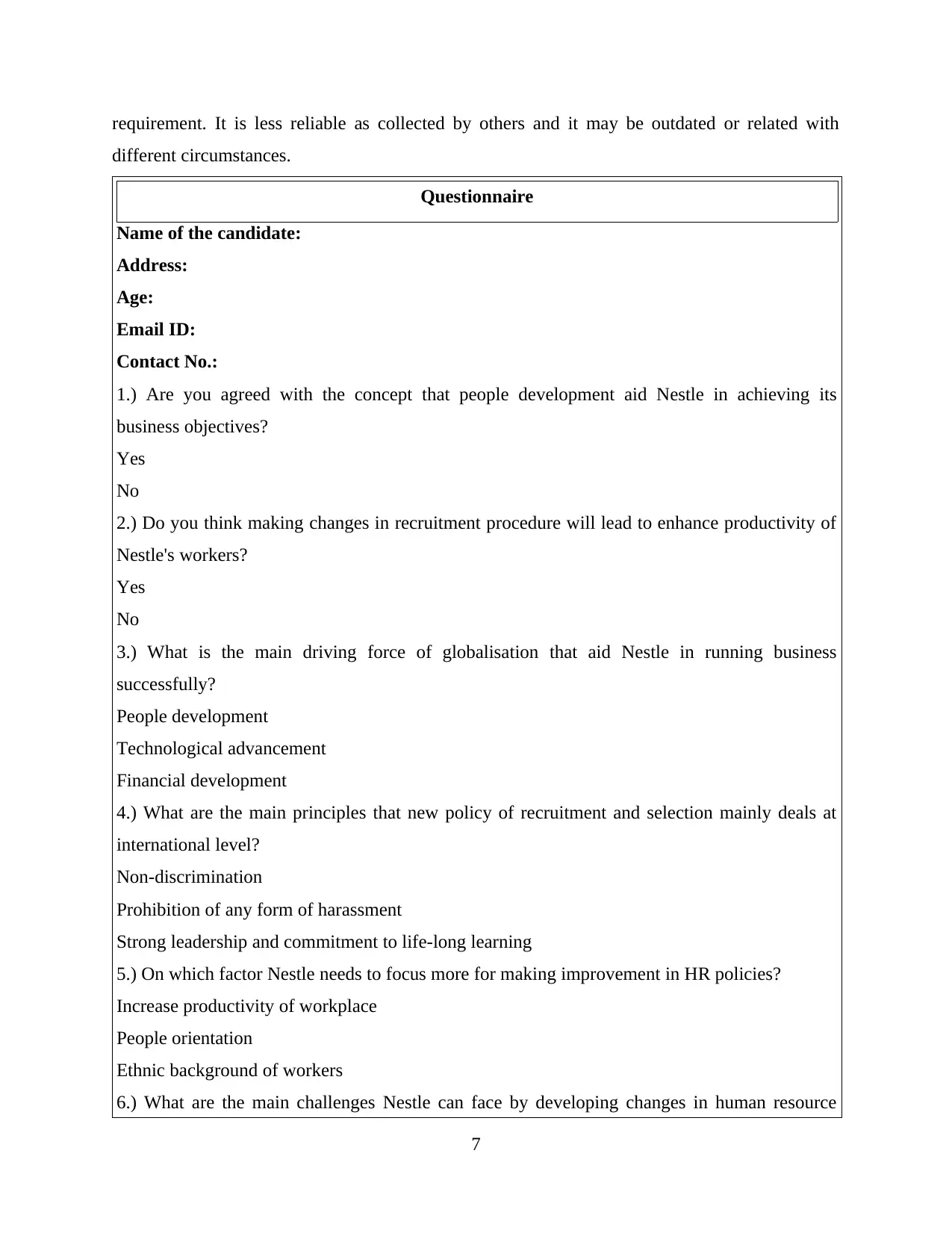
requirement. It is less reliable as collected by others and it may be outdated or related with
different circumstances.
Questionnaire
Name of the candidate:
Address:
Age:
Email ID:
Contact No.:
1.) Are you agreed with the concept that people development aid Nestle in achieving its
business objectives?
Yes
No
2.) Do you think making changes in recruitment procedure will lead to enhance productivity of
Nestle's workers?
Yes
No
3.) What is the main driving force of globalisation that aid Nestle in running business
successfully?
People development
Technological advancement
Financial development
4.) What are the main principles that new policy of recruitment and selection mainly deals at
international level?
Non-discrimination
Prohibition of any form of harassment
Strong leadership and commitment to life-long learning
5.) On which factor Nestle needs to focus more for making improvement in HR policies?
Increase productivity of workplace
People orientation
Ethnic background of workers
6.) What are the main challenges Nestle can face by developing changes in human resource
7
different circumstances.
Questionnaire
Name of the candidate:
Address:
Age:
Email ID:
Contact No.:
1.) Are you agreed with the concept that people development aid Nestle in achieving its
business objectives?
Yes
No
2.) Do you think making changes in recruitment procedure will lead to enhance productivity of
Nestle's workers?
Yes
No
3.) What is the main driving force of globalisation that aid Nestle in running business
successfully?
People development
Technological advancement
Financial development
4.) What are the main principles that new policy of recruitment and selection mainly deals at
international level?
Non-discrimination
Prohibition of any form of harassment
Strong leadership and commitment to life-long learning
5.) On which factor Nestle needs to focus more for making improvement in HR policies?
Increase productivity of workplace
People orientation
Ethnic background of workers
6.) What are the main challenges Nestle can face by developing changes in human resource
7
Paraphrase This Document
Need a fresh take? Get an instant paraphrase of this document with our AI Paraphraser
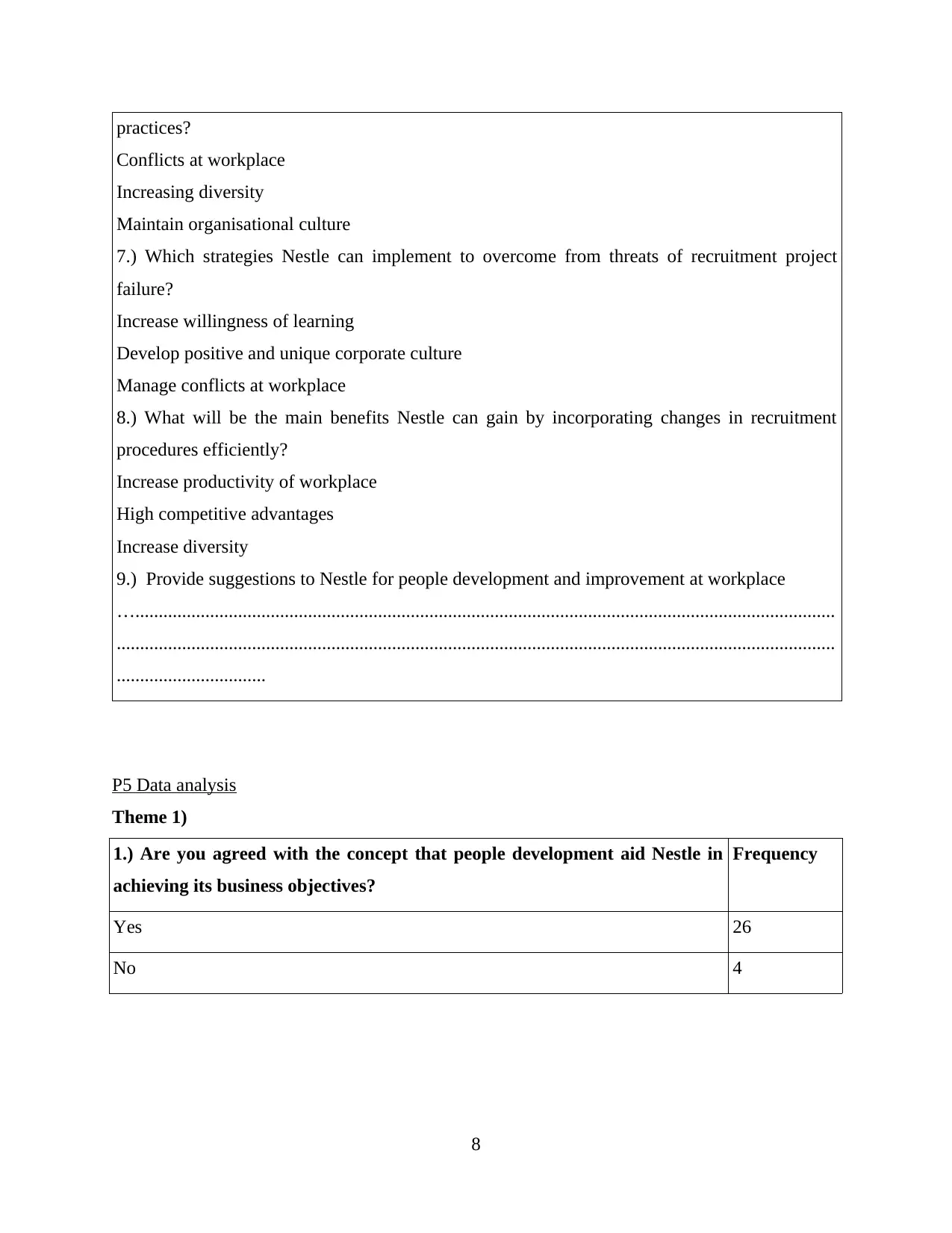
practices?
Conflicts at workplace
Increasing diversity
Maintain organisational culture
7.) Which strategies Nestle can implement to overcome from threats of recruitment project
failure?
Increase willingness of learning
Develop positive and unique corporate culture
Manage conflicts at workplace
8.) What will be the main benefits Nestle can gain by incorporating changes in recruitment
procedures efficiently?
Increase productivity of workplace
High competitive advantages
Increase diversity
9.) Provide suggestions to Nestle for people development and improvement at workplace
…......................................................................................................................................................
..........................................................................................................................................................
................................
P5 Data analysis
Theme 1)
1.) Are you agreed with the concept that people development aid Nestle in
achieving its business objectives?
Frequency
Yes 26
No 4
8
Conflicts at workplace
Increasing diversity
Maintain organisational culture
7.) Which strategies Nestle can implement to overcome from threats of recruitment project
failure?
Increase willingness of learning
Develop positive and unique corporate culture
Manage conflicts at workplace
8.) What will be the main benefits Nestle can gain by incorporating changes in recruitment
procedures efficiently?
Increase productivity of workplace
High competitive advantages
Increase diversity
9.) Provide suggestions to Nestle for people development and improvement at workplace
…......................................................................................................................................................
..........................................................................................................................................................
................................
P5 Data analysis
Theme 1)
1.) Are you agreed with the concept that people development aid Nestle in
achieving its business objectives?
Frequency
Yes 26
No 4
8
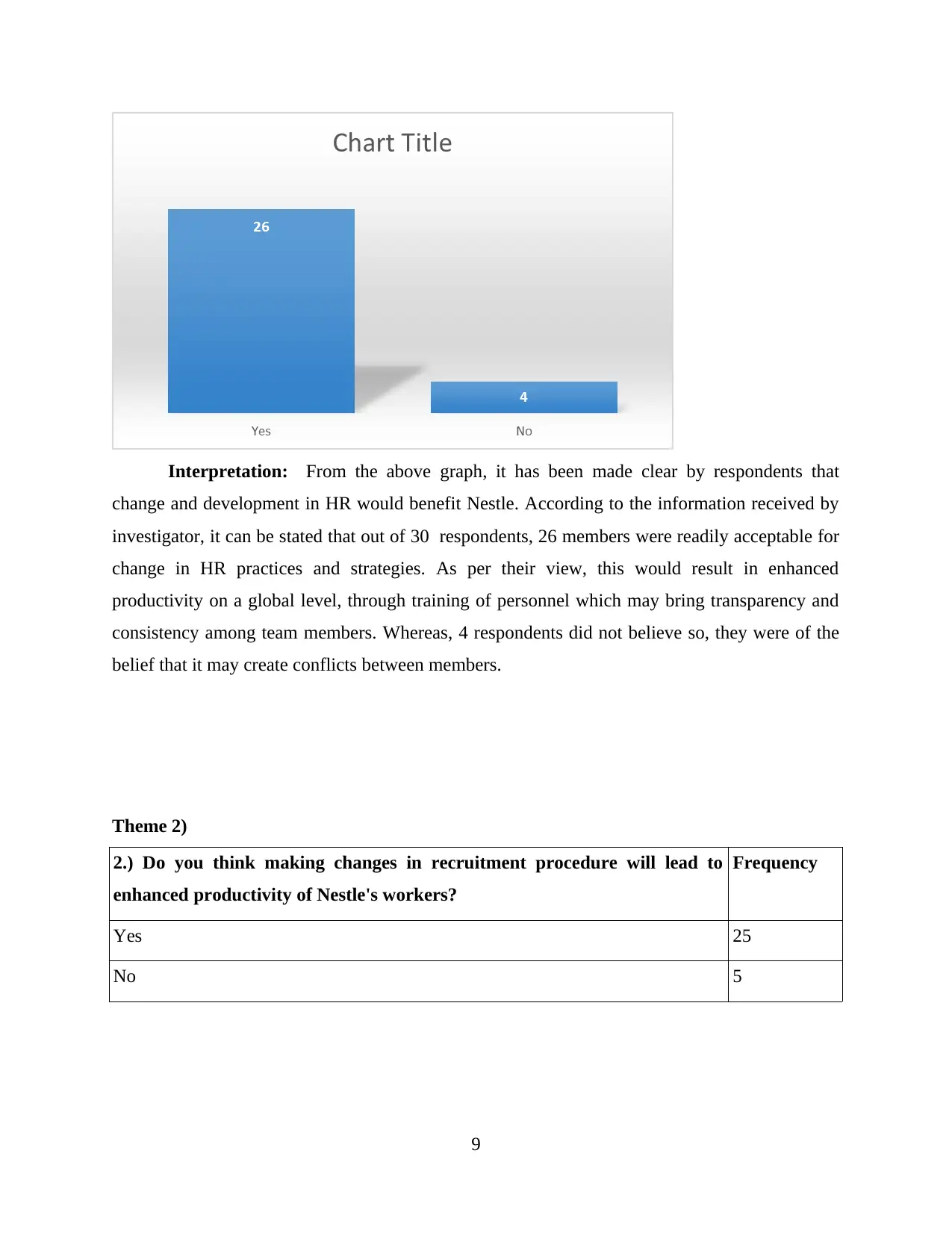
Interpretation: From the above graph, it has been made clear by respondents that
change and development in HR would benefit Nestle. According to the information received by
investigator, it can be stated that out of 30 respondents, 26 members were readily acceptable for
change in HR practices and strategies. As per their view, this would result in enhanced
productivity on a global level, through training of personnel which may bring transparency and
consistency among team members. Whereas, 4 respondents did not believe so, they were of the
belief that it may create conflicts between members.
Theme 2)
2.) Do you think making changes in recruitment procedure will lead to
enhanced productivity of Nestle's workers?
Frequency
Yes 25
No 5
9
change and development in HR would benefit Nestle. According to the information received by
investigator, it can be stated that out of 30 respondents, 26 members were readily acceptable for
change in HR practices and strategies. As per their view, this would result in enhanced
productivity on a global level, through training of personnel which may bring transparency and
consistency among team members. Whereas, 4 respondents did not believe so, they were of the
belief that it may create conflicts between members.
Theme 2)
2.) Do you think making changes in recruitment procedure will lead to
enhanced productivity of Nestle's workers?
Frequency
Yes 25
No 5
9
⊘ This is a preview!⊘
Do you want full access?
Subscribe today to unlock all pages.

Trusted by 1+ million students worldwide
1 out of 25
Related Documents
Your All-in-One AI-Powered Toolkit for Academic Success.
+13062052269
info@desklib.com
Available 24*7 on WhatsApp / Email
![[object Object]](/_next/static/media/star-bottom.7253800d.svg)
Unlock your academic potential
Copyright © 2020–2025 A2Z Services. All Rights Reserved. Developed and managed by ZUCOL.





